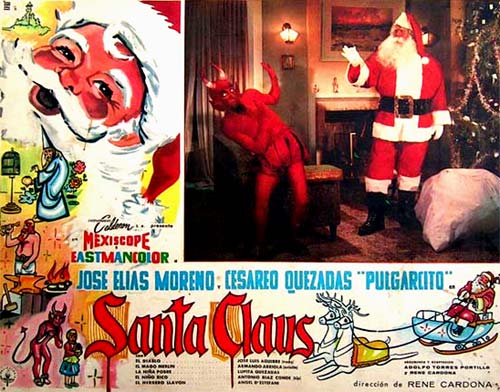 Santa versus Satan? That’s the premise of this “classic” Mexi kid flick from 1959, a colorful and totally bizarre take on Jolly Ol’ Saint Nick. Fans of THE 5,000 FINGERS OF DR. T and WILLIE WONKA AND THE CHOCOLATE FACTORY should enjoy this trippy concoction, although they’ll have to endure a surfeit of nauseating sweetness. The version of SANTA CLAUS under review here is FYI the original 96-minute Mexican edit, not the recut English dubbed version.
Santa versus Satan? That’s the premise of this “classic” Mexi kid flick from 1959, a colorful and totally bizarre take on Jolly Ol’ Saint Nick. Fans of THE 5,000 FINGERS OF DR. T and WILLIE WONKA AND THE CHOCOLATE FACTORY should enjoy this trippy concoction, although they’ll have to endure a surfeit of nauseating sweetness. The version of SANTA CLAUS under review here is FYI the original 96-minute Mexican edit, not the recut English dubbed version.
Much of the weirdness of this film, from my perspective at least, is most likely due to the cultural divide between the US and Mexico…and differing perceptions of the particulars of Santa Claus. In this film, Santa operates from a cloud high above the North Pole and uses mechanical reindeer to guide his slay (there’s no Rudolph). It seems that Santa Claus is intended as nothing less than a stand-in for God Himself. The presence of Satan and his minion of devilish followers is another new and unexpected element, as is a cameo by Merlin the Magician.
Director Rene Cardona, Sr. is largely responsible for the film’s outre edge (the US version, incidentally, was reedited by K. Gordon Murray). Cardona was one of Mexico’s most prolific filmmakers; SANTA CLAUS was actually one of six films he directed in 1959! Other notable Cardona efforts include WRESTLING WOMEN VS. THE AZTEC MUMMY and NIGHT OF THE BLODY APES, films that have more in common with this one than you might think.
So: In his palace above the earth Santa Claus hosts a gathering of children from around the world who, divided into groups representing each different country, perform musical numbers unique to their culture (and proving that cultural stereotypes aren’t unique to Hollywood!). Meanwhile, down in Hell, the Devil is looking to tarnish the Spirit of Christmas by sending his emissaries aboveground, where they try and convince kids to do evil things like break department store windows and steal toys. They also give innocent children scary dreams (like a young girl harassed by dancing human-sized dolls). Santa observes all this through his customized telescope, consisting of a big eye at the end of a long stalk that can speak to him via a pair of giant lips.
Santa, in preparation for Christmas Eve, visits his friend Merlin the Magician, who gives him a magic flower that can turn him invisible. Next, Santa winds up his mechanical reindeer and takes off in his sleigh. The Devil steps up his campaign of harassment, booby-trapping the first few chimneys Santa tries to slide down. Santa counterattacks by entering kids’ houses through windows and shooting the offending Devil in the butt with a toy arrow.
But the Big D won’t stop. He inspires three young kids to fight, throws away Merlin’s magic flower and sicks a dog on our corpulent hero, trapping him in a tree. When a concerned parent tries to call the police, the Devil breathes into the phone, causing flame to shoot out of the receiving end. Merlin saves the day, animating a toy mutt in Santa’s bag that distracts the attacking dog long enough for Santa to escape and continue his work undistracted.
Visually, this is a startlingly vivid, colorful effort. The budget was evidently quite substantial and has resulted in astonishingly opulent—and bizarre—visual design. That said, the film seems needlessly chatty; there’s even an ever-present narrator to fill us in on what’s going on from minute to minute (which didn’t do much for me, as the version I viewed was an unsubtitled Spanish language print).
This film being from the maker of NIGHT OF THE BLOODY APES, it has an endearing tackiness, particularly in the devil costumes, which consist of skin-tight red leotards and (patently fake) pointy ears. The problem is with the tone, which is so obnoxiously sugary it makes sitting through SANTA CLAUS an endurance test for all but the hardiest kid movie viewers.
Vital Statistics
SANTA CLAUS
Cinematographica Calderon S.A.
Director: Rene Cardona
Producer: Guillermo Calderon
Screenplay: Rene Cardona, Adolfo Torres Portillo
Cinematography: Raul Martinez Solares
Editor: Jorge Bustos
Cast: Jose Elias Moreno, Jose Luis Aguirre, Cesareo Quezadas, Armando Arriola, Polo Ortin, Nora Veryan, Lupita Quezadas, Angel Di Stefani
